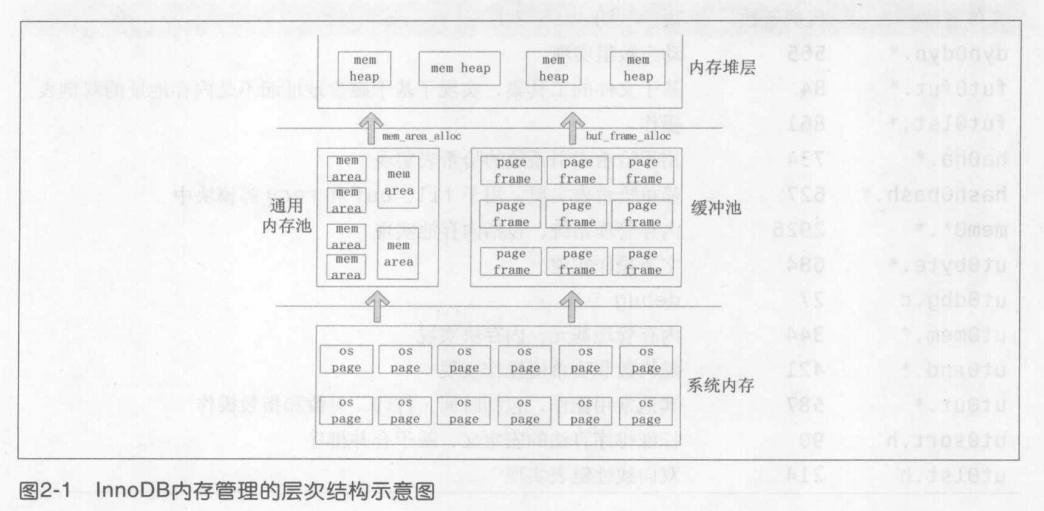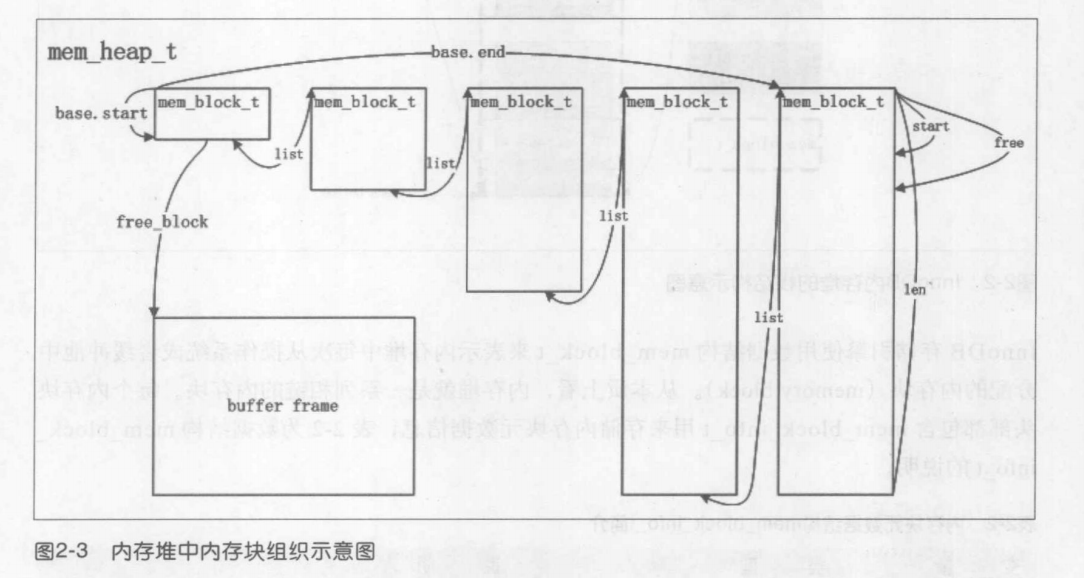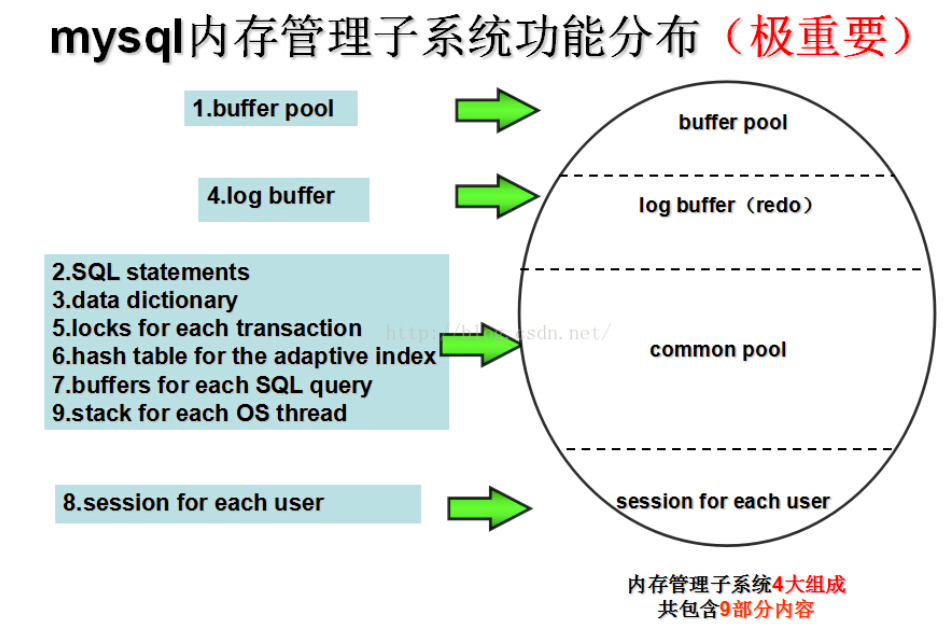innodb源码解析 - mem0_.c - 基本内存管理
The basic element of the memory management is called a memory
heap. A memory heap is conceptually a
stack from which memory can be allocated. The stack may grow infinitely.
The top element of the stack may be freed, or
the whole stack can be freed at one time. The advantage of the
memory heap concept is that we can avoid using the malloc and free
functions of C which are quite expensive, for example, on the Solaris + GCC
system (50 MHz Sparc, 1993) the pair takes 3 microseconds,
on Win NT + 100MHz Pentium, 2.5 microseconds.
When we use a memory heap,
we can allocate larger blocks of memory at a time and thus
reduce overhead. Slightly more efficient the method is when we
allocate the memory from the index page buffer pool, as we can
claim a new page fast. This is called buffer allocation.
When we allocate the memory from the dynamic memory of the
C environment, that is called dynamic allocation.
Innodb内存管理的基本概念是一个内存堆,内存堆在概念上是一个stack,这个stack可能无限增长。这样的分配方式可以将多次的内存分配合并为单次进行,之后的内存请求就可以在Innodb内部进行,避免了多次频繁调用malloc和free的性能开销。此外,Innodb存储引擎还允许从缓冲池中分配内存建立内存堆,这样可以更快速的请求内存页。这种分配方式为缓冲区分配。将使用malloc分配内存的方法称为动态分配。
The default way of operation of the memory heap is the following.
First, when the heap is created, an initial block of memory is
allocated. In dynamic allocation this may be about 50 bytes.
If more space is needed, additional blocks are allocated
and they are put into a linked list.
After the initial block, each allocated block is twice the size of the previous, until a threshold is attained, after which the sizes of the blocks stay the same. An exception is, of course, the case where the caller requests a memory buffer whose size is bigger than the threshold. In that case a block big enough must be allocated.
The heap is physically arranged so that if the current block
becomes full, a new block is allocated and always inserted in the chain of blocks as the last block.
内存堆的分配方式如下:
首先,创建内存堆时,会使用动态分配创建一个大约的50bytes(64B)的初始的内存块。如果需要额外的空间,则分配更多的内存块,大小为前一个内存块的2倍,直到达到最阈值,之后的内存块大小保持不变,与之前的内存块组成一个 linked list。
当调用方请求的内存缓冲区大小超出阈值,则直接分配一个足够大小的内存块。

Innodb存储引擎使用 mem_block_t 来表示从内存或者缓冲池中分配的内存块,每个内存块头部都有一个mem_block_info_t 来保存内存堆的元数据信息。
1 2 3 4 5 6 7 8 9 10 11 12 13 14 15 16 17 18 19 20 21 22 23 24 25 26 27 28 29 30 31 32 33 | struct mem_block_info_struct { ulint magic_n;/* magic number for debugging */<br> //内存堆创建的文件名 char file_name[8];/* file name where the mem heap was created */<br> //内存堆创建的文件行号 ulint line; /* line number where the mem heap was created */<br> //用于链接内存堆中内存块的链表基节点,仅在内存堆的第一个内存块中定义 UT_LIST_BASE_NODE_T(mem_block_t) base; /* In the first block in the the list this is the base node of the list of blocks; in subsequent blocks this is undefined */<br> //用于链接内存堆中各内存块的链表节点 UT_LIST_NODE_T(mem_block_t) list; /* This contains pointers to next and prev in the list. The first block allocated to the heap is also the first block in this list, though it also contains the base node of the list. */<br> //内存块的大小 ulint len; /* physical length of this block in bytes */<br> //内存块的类型,分为以下三类:MEM_HEAP_DYNAMIC MEM_HEAP_BUF MEM_HEAR_BTR_SEARCH ulint type; /* type of heap: MEM_HEAP_DYNAMIC, or MEM_HEAP_BUF possibly ORed to MEM_HEAP_BTR_SEARCH */<br> //如果为true,表示该内存块用于快速创建内存堆:内存将被创建者释放,而不是 mem_heap_free ibool init_block; /* TRUE if this is the first block used in fast creation of a heap: the memory will be freed by the creator, not by mem_heap_free */<br> //内存块的空闲位置相对与起始位置的偏移量 ulint free; /* offset in bytes of the first free position for user data in the block */<br> // 内存块创建时的free字段偏移位置 ulint start; /* the value of the struct field 'free' at the creation of the block */<br> // 在 MEM_HEAP_BTR_SEARCH 类型的堆中用来包含一个可作为堆空闲块的缓冲页框。该字段仅在堆需要更多空间时使用 byte* free_block; /* if the MEM_HEAP_BTR_SEARCH bit is set in type, and this is the heap root, this can contain an allocated buffer frame, which can be appended as a free block to the heap, if we need more space; otherwise, this is NULL */#ifdef MEM_PERIODIC_CHECK UT_LIST_NODE_T(mem_block_t) mem_block_list; /* List of all mem blocks allocated; protected by the mem_comm_pool mutex */#endif}; |
Innodb存储引擎定义了三种内存堆类型:
1 | MEM_HEAP_DYNAMIC:堆的内存调用通用内存池接口申请,使用malloc分配 |
1 | MEM_HEAP_BUF:堆的内存从缓冲池中申请 |
1 | MEM_HEAR_BTR_SEARCH:MEM_HEAP_BUF的子类型,仅在自适应hash索引中使用。 |

---------------------------------------------------------------------------------------------------------------------------------------------------------------------------------------------------------------------------
The main components of the memory consumption are:
1. buffer pool,
2. parsed and optimized SQL statements,
3. data dictionary cache,
4. log buffer,
5. locks for each transaction,
6. hash table for the adaptive index,
7. state and buffers for each SQL query currently being executed,
8. session for each user, and
9. stack for each OS thread.
Items 1-3 are managed by an LRU algorithm. Items 5 and 6 can potentially
consume very much memory. Items 7 and 8 should consume quite little memory,
and the OS should take care of item 9, which too should consume little memory.
MySQL内存管理的主要组成部分是:
1. 缓冲池
2. 分析优化过的SQL语句
3. 数据字典缓存
4. 日志缓冲区(redo)
5. 事务的锁
6. 自适应hash索引的hash表
7. 正在执行的SQL语句的查询的状态和缓冲区
8. 用户session
9. os 线程堆栈
其中,1~3通过LRU算法进行管理,5~6可能占用大量的内存,7~8占用少量的内存。操作系统处理9,也会占用少量的内存。
以上9大块通过4个部分进行管理:
1. buffer pool
2. redo log buffer
3. common buffer (2,3,5,6,7,8)
4. 8(用户session)

对于 5(事务的锁)和6(自适应hash索引),可能占用大量的内存,因此,最多可以占用通用缓冲池的大小,而后,将从buffer pool中获取内存。
在 Innodb存储引擎启动时,会有一个mem_comm_pool对象,代表着通用内存池,数据结构通过 mem_pool_struct来定义。
1 2 3 4 5 6 7 8 9 10 11 12 13 14 15 16 17 18 19 20 21 22 23 24 25 26 27 | /* Data structure for a memory pool. The space is allocated using the buddyalgorithm, where free list i contains areas of size 2 to power i. */struct mem_pool_struct{ // 内存池从操作系统中分配到的内存指针 byte* buf; /* memory pool */ // 内存池大小 ulint size; /* memory common pool size */ // 内存池中已经分配的内存大小 ulint reserved; /* amount of currently allocated memory */ // mutex锁 mutex_t mutex; /* mutex protecting this struct */ // 可用内存区域列表, 用于内存池中内存单元的管理;内存池中所有内存区指针都包含在 free_list[64]数组中。[伙伴系统] UT_LIST_BASE_NODE_T(mem_area_t) free_list[64]; /* lists of free memory areas: an area is put to the list whose number is the 2-logarithm of the area size */};struct mem_area_struct{<br> // 内存区的大小和是否空闲 ulint size_and_free; /* memory area size is obtained by anding with ~MEM_AREA_FREE; area in a free list if ANDing with MEM_AREA_FREE results in nonzero */ <br> // 用于将该内存区连接到 free_list[64]链表中 UT_LIST_NODE_T(mem_area_t) free_list; /* free list node */}; |
伙伴系统: 从内存池的管理角度分析,如果频繁的请求和释放不同大小的内存,会导致在内存池中存在大量的碎片化的小内存区。引发的问题是,即使内存池中有足够多的空闲内存可用,但是却无法分配一个大块的连续内存。Innodb内存池使用伙伴系统来解决问题:
1. 通用内存池通过 free_list 和 mem_area_struct组成伙伴系统,把内存池中内存分组为64个内存区链表,每个区链表分别包含 2^0,2^1,2^2 ... 2^64大小的内存区。
2. 对于通用内存池,如果申请一块64B的内存,则现在free_list[6] 链表中检查是否有一个空闲块。如果没有这样的块, 则在free_list[7]中寻找,如果存在,则内存池把free_list[7] 中的第一个128B内存块分为两等份,一半用于满足请求,一半插入到free_list[6]链表中。如果free_list[7]中也没有,就继续往上找。
3. 假设内存池大小为1M,初始化后为完整的内存。这时申请128KB大小的内存,内存池中没有128KB大小的内存,则往上找256KB大小,一直找到1024KB内存区。所以,此次分配会导致内存池将1M内存块分裂为 512KB,256KB和2个128KB内存区。
4. 当一个请求释放64KB内存,如果内存池中相邻一个空闲的64KB内存区,则合并为128KB的内存区。




【推荐】国内首个AI IDE,深度理解中文开发场景,立即下载体验Trae
【推荐】编程新体验,更懂你的AI,立即体验豆包MarsCode编程助手
【推荐】抖音旗下AI助手豆包,你的智能百科全书,全免费不限次数
【推荐】轻量又高性能的 SSH 工具 IShell:AI 加持,快人一步
· Linux系列:如何用heaptrack跟踪.NET程序的非托管内存泄露
· 开发者必知的日志记录最佳实践
· SQL Server 2025 AI相关能力初探
· Linux系列:如何用 C#调用 C方法造成内存泄露
· AI与.NET技术实操系列(二):开始使用ML.NET
· 被坑几百块钱后,我竟然真的恢复了删除的微信聊天记录!
· 没有Manus邀请码?试试免邀请码的MGX或者开源的OpenManus吧
· 【自荐】一款简洁、开源的在线白板工具 Drawnix
· 园子的第一款AI主题卫衣上架——"HELLO! HOW CAN I ASSIST YOU TODAY
· Docker 太简单,K8s 太复杂?w7panel 让容器管理更轻松!